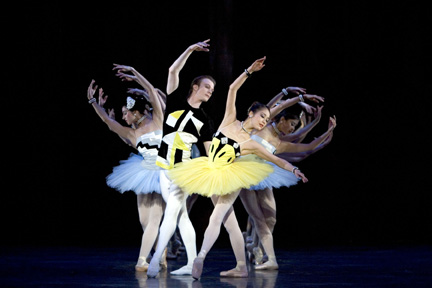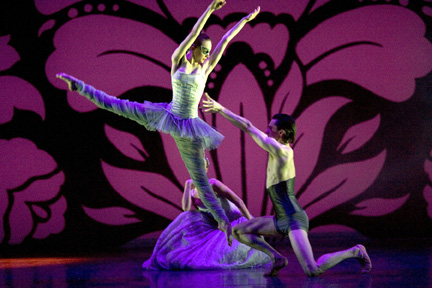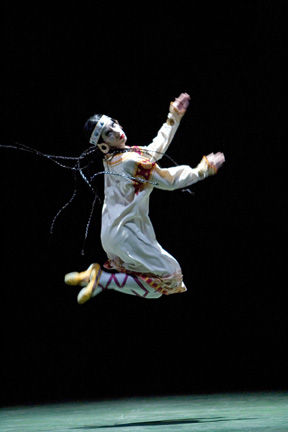“Stravinsky!
A Celebration”
“Into the Ferment”, “The Planets”
Birmingham Royal Ballet
Birmingham Hippodrome
Birmingham, England
June 8 – 18 2005
by
John Percival
copyright
©2005 by John Percival
 When
David Bintley became artistic director of Birmingham Royal Ballet ten
years ago, he said publicly that he wanted a creative company, and he
has succeeded to an extent I would not have thought possible, given the
need to maintain a local audience. This year’s spring season in
their home theatre contained no fewer than three creations, and even the
rest of the repertory was mostly unfamiliar. To make this possible, when
funds were short Bintley lately launched a Director’s Appeal to
raise money for new choreography. No wonder I wanted to see all three
programmes, and I bitterly resent the inability of British Rail to provide
an adequate Saturday service (the fault of engineering works, I believe)
which meant that I could not see the revival, after a quarter-century,
of John Cranko’s “Brouillards” and Bintley’s own
revision, for the company, of “Les Petits Riens”, which he
originally made for the Royal Ballet School in 1991.
When
David Bintley became artistic director of Birmingham Royal Ballet ten
years ago, he said publicly that he wanted a creative company, and he
has succeeded to an extent I would not have thought possible, given the
need to maintain a local audience. This year’s spring season in
their home theatre contained no fewer than three creations, and even the
rest of the repertory was mostly unfamiliar. To make this possible, when
funds were short Bintley lately launched a Director’s Appeal to
raise money for new choreography. No wonder I wanted to see all three
programmes, and I bitterly resent the inability of British Rail to provide
an adequate Saturday service (the fault of engineering works, I believe)
which meant that I could not see the revival, after a quarter-century,
of John Cranko’s “Brouillards” and Bintley’s own
revision, for the company, of “Les Petits Riens”, which he
originally made for the Royal Ballet School in 1991.
The season had begun with “Stravinsky! A Celebration”, the opening event of a three-year collaboration during which BRB and other Birmingham arts organisations will play the composer’s complete works; how many other cities worldwide could offer such an opportunity? The centre-piece of this bill was Ashton’s masterpiece “Scènes de ballet”. That alone would make the journey worth while. How odd to think that when it was premiered in 1948 the music seemed difficult (nowadays we can sing it!). Whether viewed as a tribute to Petipa or a wholly original invention, the choreography is simply great, and there were two outstanding performances in the leads—Nao Sakuma delicious as the ballerina, and Robert Parker charismatic as the chief partner—but unfortunately in two different casts, not together. Still, the ballet looked fine both times.
 Two
short works began the programme. Michael Kopinski, a soloist in the company
who has done choreography for various outside ventures, was commissioned
to stage “Dumbarton Oaks” to the Brandenburg-style concerto
of that name. It didn’t really succeed but allowed a small cast
some lively entrées; I read afterwards with surprise that they
were meant to conjure images of moths. Balanchine’s “Duo Concertant”
is, of course, in another category altogether and, thanks to the company’s
high standards and the excellent staging by Eve Lawson, I saw two couples
dance it, both of them better than the recent revival by the other Royal
Ballet company at Covent Garden. Elisha Willis and Robert Parker were
notably light and affectionate, whereas Asta Bazeviciúte and Iain
Mackay scored particularly in the mysterious final movement. Robert Gibbs,
leader of the Royal Ballet Sinfonia, the company’s associate orchestra,
and BRB’s principal pianist Jonathan Higgins were the admirable
solo players.
Two
short works began the programme. Michael Kopinski, a soloist in the company
who has done choreography for various outside ventures, was commissioned
to stage “Dumbarton Oaks” to the Brandenburg-style concerto
of that name. It didn’t really succeed but allowed a small cast
some lively entrées; I read afterwards with surprise that they
were meant to conjure images of moths. Balanchine’s “Duo Concertant”
is, of course, in another category altogether and, thanks to the company’s
high standards and the excellent staging by Eve Lawson, I saw two couples
dance it, both of them better than the recent revival by the other Royal
Ballet company at Covent Garden. Elisha Willis and Robert Parker were
notably light and affectionate, whereas Asta Bazeviciúte and Iain
Mackay scored particularly in the mysterious final movement. Robert Gibbs,
leader of the Royal Ballet Sinfonia, the company’s associate orchestra,
and BRB’s principal pianist Jonathan Higgins were the admirable
solo players.
 The
remaining work on this bill was “The Rite of Spring”, and
apropos the Royal Ballet Sinfonia and its music director Barry Wordsworth
I must mention that the arts editor of the Birmingham Post, who doesn’t
like ballet, came along for once and declared with surprise that Birmingham
has two world class orchestras (the other being the, to him more familiar,
City of Birmingham Symphony Orchestra). BRB is proud to be the first British
company to give the reconstruction by Millicent Hodson of Nijinsky’s
1913 choreography and by Kenneth Archer of Nicholas Roerich’s designs.
That’s fair enough, given Bintley’s description of it as “this
monumental work that changed the course of ballet in the 20th century”,
and I must say that the reconstruction is more convincing than other Nijinsky
ballets I have seen Hodson and Archer attempt—their “Jeux”
and “Till Eulenspiegel” simply don’t explain the original
success of those works (less documentation was available for them). But
I will add that by far the best version of “Rite” I have seen
was Leonide Massine’s, first given in 1920, and after that I would
place Pina Bausch’s and Maurice Béjart’s more modern
treatments. Massine used the same designs as Nijinsky but simplified the
structure. “Rite” was probably too big and complex a subject
for the inexperienced Nijinsky, for all the originality of his thought
and ambition. I’d say that it was Stravinsky’s music for “Rite”
coupled with Nijinsky’s other, smaller but inventive choreographies
that changed the art. So I am unimpressed by BRB’s revival, well
enough though they carried it off.
The
remaining work on this bill was “The Rite of Spring”, and
apropos the Royal Ballet Sinfonia and its music director Barry Wordsworth
I must mention that the arts editor of the Birmingham Post, who doesn’t
like ballet, came along for once and declared with surprise that Birmingham
has two world class orchestras (the other being the, to him more familiar,
City of Birmingham Symphony Orchestra). BRB is proud to be the first British
company to give the reconstruction by Millicent Hodson of Nijinsky’s
1913 choreography and by Kenneth Archer of Nicholas Roerich’s designs.
That’s fair enough, given Bintley’s description of it as “this
monumental work that changed the course of ballet in the 20th century”,
and I must say that the reconstruction is more convincing than other Nijinsky
ballets I have seen Hodson and Archer attempt—their “Jeux”
and “Till Eulenspiegel” simply don’t explain the original
success of those works (less documentation was available for them). But
I will add that by far the best version of “Rite” I have seen
was Leonide Massine’s, first given in 1920, and after that I would
place Pina Bausch’s and Maurice Béjart’s more modern
treatments. Massine used the same designs as Nijinsky but simplified the
structure. “Rite” was probably too big and complex a subject
for the inexperienced Nijinsky, for all the originality of his thought
and ambition. I’d say that it was Stravinsky’s music for “Rite”
coupled with Nijinsky’s other, smaller but inventive choreographies
that changed the art. So I am unimpressed by BRB’s revival, well
enough though they carried it off.
Programme two was all new choreography and offered as a bargain deal—all seats at £10. It began with “Into the Ferment”, staged by soloist Jonathan Payn to a score by James MacMillan, which itself derives from a poem by Robert Burns. It concerns three young chaps, the whisky they drink and the girl they try to pick up. The narrative of it didn’t come off for me, nor was it clear why two of the guys seemed to be wearing football kit. Rory Mackay, James Grundy and Tyrone Singleton danced as though they might have known the point, and Virginia de Gersigny made a cute heroine.
For “The Planets”, Bintley took up an idea he has tried before, asking a group of would-be choreographers within the company each to tackle part of a big score. Kopinski was one of them, and he chose Saturn. The others were another soloist, Lei Zhao (Jupiter), and corps members Samara Downs (Mercury), Kit Holder (Uranus) and Jenny Murphy (Neptune). Bintley also invited a locally based contemporary dancer, Rosie Kay, to undertake one section, Mars, and himself took on Venus, without any influence, I think, from his staging of the full ballet at Covent Garden some years ago, which flopped at least partly because its over-ambitious décor didn’t work.
None of this new “Planets” was great, but none of it was boring either. My chief complaint would be that the style of the sections varied more choreographically than musically. It wasn’t meant to endure, and it will not; but it achieved its purpose of giving several aspiring dance-makers the chance to work with good dancers – who themselves got extra experience through it. In the context of this enterprising company, that’s fine.
Photos:
First : The company in "Scenes de ballet." Photo by Bill
Cooper.
Second: "Dumbarton Oaks." Photo by Bill Cooper.
Third: The Chosen One (not identified) in "Le Sacre de Printemps."
Photo by Bill Cooper.
Volume 3,
No. 24
June 20, 2005
copyright
©2005
John Percival
www.danceviewtimes.com
|
|